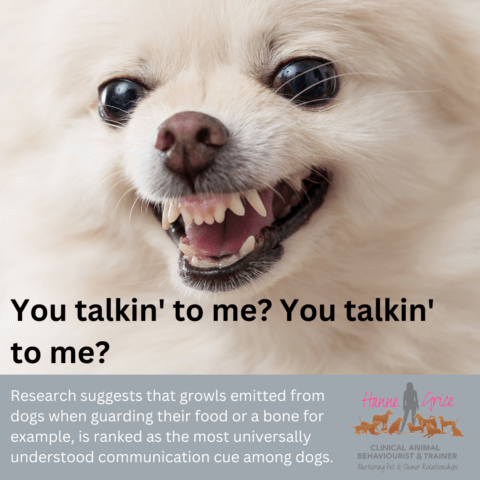
When Robert De Nero looked into the mirror and uttered those famous lines “You talkin’ to me? You talkin’ to me” in the film Taxi Driver, his menacing message was clear – back off or they’ll be trouble.
Research suggests that growls emitted from dogs when guarding their food or a bone for example, is ranked as the most universally understood communication cue among dogs.
The study, that was made by Tamas Farago, Peter Pongracz, Friederike Range, Zsofia Viranyi and Adam Miklosi, investigated canine communication in three situations; a threatening social conflict, when guarding food and during play.
Using 20 adults dogs of differing breeds, ages, sizes and sex, their simulated a threatening situation where the dog’s owner had the dog on the lead while a stranger walked by slowly, approaching the dog and staring directly at it. To produce a playful growl, the owner and dog played a game of tug of war. And in the final experiment, a dog was given a tasty meat bone and when he started to chew on it, another unfamiliar dog was led out and approached the dog chewing the bone. The study wanted to see if a dog understood and then react to another dog’s growl? Once all the growls were recorded, 41 dogs were recruited to listen to the growls. Using a speaker hidden in a dog crate, covered over next to a cooked bone, the test dog and owner would enter. The owner wasn’t allowed to interact with their dog, however, they had to led the dog around the room enabling it to sniff towards the bone (by approx eight inches). The owner then had take their dog off the lead. When the dog got within two inches of the bone, the researchers would play a growl sequence. The researchers watched how frequently the dog made contact with the bone or left it, and noted the duration of licking, chewing, and taking the bone away from its original location of the encounter.
After hearing the growl for the first time, 11 out of 12 dogs in the food guarding growl group withdrew from the bone within 15 seconds. Only two of the 12 dogs from the threatening-growl group, and four of the 12 dogs in the play-growl group withdrew in the same time frame. While 7 dogs from the food-guarding growl group didn’t go near the bone again within the next 90 seconds. Only one dog in each of the threatening-growl and play-growl groups stayed permanently away from the bone.
The study results found that the food guarding growls were a much stronger deterrent to the dogs than when the researchers played back the threatening growls and the play growl recordings.
The researchers also found there was a significant difference in the acoustic quality between play growls and the food guarding and threatening growls. Play growls were much shorter, at least half as short and higher pitched than the other two types of growls.
So, as the study suggests it appears that dogs are extremely capable of deciphering another dog’s growl when it comes to a tasty meaty bone!
Listen below to the recordings* made by the researcher team in this study.
Learn more about our classes

Get Hanne's book, clothing and more
Hanne has a number of publications including her book Playing With Your Dog to help owners work out the games that are best suited for their pet to play throughout his life, from puppyhood to old age, available from Amazon. Check out Hanne's range of contemporary casuals The Collection – for pet lovers made from recyclable, organic materials that are sustainably sourced.

